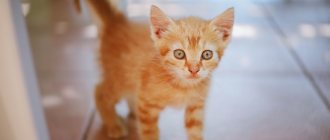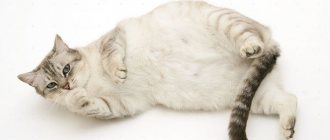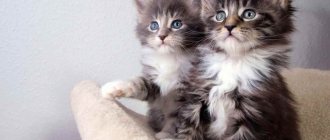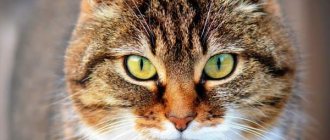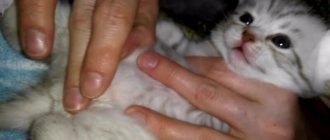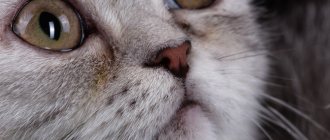13038Administration
Waiting for kittens from a pet is a trembling and responsible event, especially if the cat is preparing to become a mother for the first time. The question of when the kittens of a pregnant cat begin to move worries, perhaps, all owners - after all, this is a sure sign that the pregnancy is proceeding normally and the health of the babies and mother is in perfect order.
On average, the gestation period for kittens is two months. Depending on the breed and size of the animal, as well as some genetic characteristics, these periods can vary from 58 days to 72. The more kittens in the womb, the shorter the duration of pregnancy, the sooner they will begin to move. Accordingly, 1-2 babies will be born a little faster.
Beginning of pregnancy
The intrauterine development of a kitten goes through several important stages, when, starting from the moment of fertilization of the egg, it increases in size by more than a hundred times!
Between 11 and 13 days after fertilization, implantation of the embryo occurs - its attachment to the wall of the uterus.
© shutterstock
Further, in the period from 10 to 24 days, the process of formation of vital internal organs occurs. At this time, the cat’s mood may begin to change, its appetite may improve, or, conversely, it may worsen. The first signs of pregnancy become noticeable at this time. A pregnant cat does not require special care ; it is only important to provide it with high-quality, balanced nutrition and protect it from harmful factors: do not give medications without a veterinarian’s prescription, do not vaccinate, and do not treat the fur with chemicals against insects.
Starting at 4 weeks, an experienced veterinarian can easily feel the kittens in the cat's stomach.
Now the embryos are quite similar in appearance to real kittens. But their first movements will begin a little later - while the babies are “busy” with other important things, it is too early for them to move. You should not try to palpate the abdomen yourself - this can easily cause a miscarriage.
Pregnancy and childbirth in cats
The sexual maturity of a cat comes with the onset of the female's first heat. Estrus is characterized by bloody discharge from the cat's vagina and heat (the time when the female is able to conceive offspring).
Theoretically, with the arrival of the first heat, the cat is ready to become a mother. This ability persists throughout the animal’s life until the extinction of sexual function (usually at 7–8 years). However, it is better to avoid mating during the first heat, since early pregnancy is dangerous for the life of the mother and kittens.
The average age of puberty in young females is 7–9 months. This period may be shorter due to certain factors:
- Breed: some exotic individuals (Siamese, Thai) reach maturity earlier.
- Anatomy: those with a fragile physique mature earlier.
- Time of year: kittens born in winter have their first heat earlier.
- Housing conditions: usually animals kept in nurseries with a certain number of adults mature earlier.
- Heredity.
Sometimes the ability to bear children occurs by 1 year or even later. This is affected by:
- Constitution: Cats with a large build or excess weight “mature” later.
- Breed: long-haired representatives of different breeds are distinguished by later puberty.
- Heredity.
It’s easy to guess from the cat’s behavior that puberty is approaching. The most characteristic signs are excessive “affectionateness”, inviting yelling, arching of the back, rolling on the floor.
If you stroke your pet, a wave of vibration runs along the back and the cat moves its tail - it is ready to mate.
At this time, the owner should exercise special caution. The first heat lasts up to two weeks, the animal’s desire either increases or decreases
During the entire period of estrus, she can become pregnant.
It doesn’t matter whether the owner is engaged in breeding or not - mating a cat in her first heat is unacceptable! This poses a threat to the pet’s life due to physical immaturity.
The cat’s body finally matures by the age of 1 year, when the formation of all structures and internal organs of the animal is completed. The presence of estrus only indicates potential fertility.
Estrus occurs up to three times a year, and the most fertile cats are able to give birth as many times a year. However, pregnancy and childbirth are serious stress for the animal’s body, and lack of control over the situation is unacceptable. There are four periods of estrus:
- 1. Proestrus is the primary phase. It is characterized by swelling of the vaginal loop and the release of a small amount of mucus. Behavioral characteristics are expressed in increased affection, sometimes increased appetite. During this period, the female will not let the male near her. Proestrus lasts 1–4 days.
- 2. Estrus. The period lasts up to one and a half weeks, typical signs of sexual heat appear to the maximum. The most favorable time for mating is 4–5 days.
- 3. Metestrus - decline in sexual activity. Lasts up to two weeks. At this time, females do not allow males to approach, protecting possible offspring. The cat may not become pregnant, but retains signs of conception. This is a phenomenon of false pregnancy, the symptoms of which will disappear a month and a half after estrus.
- 4. Anestrus. The final stage of the reproductive cycle occurs if fertilization has not occurred. The animal calms down until the next heat.
Due to the length of the cycle and the increased sexual activity of some animals, it may seem that the desire to mate in cats is almost continuous.
If the cat is not taken care of and sexual intercourse with the cat takes place, pregnancy may occur. Then the pet owner should prepare for childbirth. Although sterilization is possible, it is dangerous for the animal’s life. Between the undesirable consequences of early birth and the risks of sterilization of a pregnant cat, it is more correct to choose bearing offspring.
If further breeding of animals is not planned, you can sterilize the cat after the first birth, when the body has fully recovered. Such an operation is dangerous because it is not carried out in the early stages: the owner of the animal almost never even realizes that the cat has a litter until obvious signs, when the operation is no longer possible.
Symptoms of the appearance of parasites in the body may include:
- frequent colds
- weight loss
- flatulence
- tired and hungry
- headaches, as well as various pains and spasms in the internal organs especially!
If you have a pet, then you are definitely at risk!
If you have these symptoms, you simply need to cleanse your body. How to do this read here >>
Period of active movements
Kittens begin to move around 5-6 weeks . At first they are quite rare, then the babies begin to move more and more often.
By this time, their paws and toes had already formed, skin had appeared on their body, and the first hairs had begun to sprout. During this period, babies develop their basic senses: hearing, touch, and smell. The nervous and muscular systems continue to develop.
© shutterstock
Features of pregnancy in the second half of the term:
- The cat's belly becomes quite noticeable, its shape becomes pear-shaped, since the kittens are located in the belly area. Moreover, if a cat is expecting 1-2 kittens, the belly may not be visible at all.
- At this stage, experienced owners can feel the heads and determine the number of kittens in the stomach. True, this is not so easy to do - especially when they begin to move a lot.
- Closer to the 7th week, it is already clearly noticeable from the outside how the kittens move, if the cat’s hair is not too long.
- The cat becomes more careful, avoids jumping from heights, seeks shelter, eats and sleeps a lot, and moves little.
- Kittens, as a rule, are quite mobile and move a lot during the day: they can stretch, make massaging movements with their paws, and push each other. When swallowing amniotic fluid, babies may hiccup – these movements can also be noticeable. If the litter is expected to be large, then at times it seems as if the cat’s belly is literally shaking.
At 7-8 weeks, the cat’s stomach becomes less and less space, and the kittens begin to move with a vengeance. The activity of children at times greatly disturbs the cat; she seeks solitude and hides in secluded corners. At this stage, you can easily feel how the babies move through the wall of the abdomen - you just need to put your hand.
When can you feel kittens move?
A pregnant cat's kittens begin to move when the seventh week of pregnancy arrives. Sometimes movements can begin a week earlier. If you put your hand on the belly of the expectant mother, you can feel the movements of the kitten. And about a week before giving birth, abdominal movements are visible to the naked eye. Before birth, babies move especially actively, firstly, because already at birth they have the ability to crawl, and secondly, with this activity they stimulate contractions of the uterus and the onset of labor.
Childbirth is approaching
After about 9 weeks, the baby’s body is fully formed and they are ready to be born. The gestation period for each cat breed is different, but in general it can differ by 5-7 days, up or down.
© shutterstock
If 2-3 weeks before the onset of birth, babies begin to actively move, then a few days before the important date, their mobility may decrease - this is completely normal, you should not be afraid of this phenomenon.
The cat's behavior changes: it may suddenly lose its appetite, become restless, it meows a lot and looks for a place to give birth. She produces milk.
Usually cats cope well with childbirth on their own, however, to be on the safe side, it is important to have first aid supplies for the animal and the phone number of a trusted veterinarian on hand. Don't leave your cat alone if she's close to giving birth.
Is my cat pregnant
It is recommended to plan your cat’s first pregnancy after a year, or better yet, by one and a half years. Early pregnancy is undesirable for a cat, as it has a negative impact on the still fragile spine, is difficult and can lead to the birth of weak kittens.
There are no pregnancy tests for cats. You can determine whether your pet is pregnant no earlier than three weeks after mating. The following signs will help indicate that your cat is “in position”:
- approximately 20 days after mating, the cat's nipples become bright pink;
- the cat sleeps more than usual, and in general its activity decreases;
- sometimes vomiting occurs (in the 3rd week of pregnancy).
A veterinarian can determine pregnancy by gently palpating the cat’s abdomen. This method works until the 20th day of pregnancy. Then palpation will not give results, because in the 3rd week the cat’s stomach fills with fluid, and it is difficult to feel the fruits. This is not even recommended, since pressing your fingers on the cat’s belly can harm the babies.
The duration of pregnancy in cats ranges from 58 to 72 days. Moreover, this period depends on the breed of cats. In long-haired cats, pregnancy lasts from 62 to 72 days. British and Scottish Folds carry kittens for 63-67 days.
But for “hairless” and short-haired cats this period is shorter. They typically carry kittens for 58 to 68 days. In Abyssinian cats and Maine Coons, pregnancy lasts an average of 65 days, and in Sphynx cats it lasts 63 days.
Methods for assessing the “adequacy” of fetal movements
Counting the number of movements
The easiest way to assess fetal movements is to count the number of movements by the pregnant woman herself. Self-assessment methods are very easy to use, do not require additional equipment or the presence of a doctor, and are easily reproduced by any woman. Their disadvantages are that each woman has different thresholds of susceptibility.
"Count to Ten"
The most common method for assessing fetal movements is called “count to ten” . It can be performed after 28 weeks of pregnancy, when the fetus is mature enough for active movements. Its essence lies in the fact that the expectant mother counts the movements of the fetus over a 12-hour period of time, for example from 9 am to 9 pm. The time when the pregnant woman detects the tenth movement is recorded on a tablet. If the fetus makes less than 10 movements in 12 hours, this is a reason to consult a doctor for further examination.
Sadowski method
In the evening after dinner (approximately from 19 to 23 hours), the woman lies on her left side and counts the movements of the fetus. At the same time, everything is counted, even the smallest movements. If 10 or more movements are noted within an hour, this indicates that the baby is moving quite actively and feels well. If the fetus moved less than 10 times in an hour, then the movements are counted over the next hour. The evening time for this assessment method was not chosen by chance. It is in the evening hours, especially after dinner and the associated increase in glucose, that the greatest activity of the fetus is observed. If the number of fetal movements during this test is less than 10 in two hours, this should be considered as a sign of a violation of its condition and additional research should be carried out.
For an obstetrician-gynecologist, fetal movements are also an important diagnostic criterion for certain deviations in the course of pregnancy from the norm. Too active, violent, painful movement of the fetus or weak, infrequent movements may indicate its unfavorable condition.
Features of caring for a cat during pregnancy
In order for a cat to give birth to healthy kittens and feel good during pregnancy and after birth, the owner must follow the following recommendations:
- One, or better yet, show the animal to a veterinarian several times in order to confirm pregnancy using an ultrasound examination, find out the approximate due date and rule out pathologies in the development of kittens.
- Immediately consult a specialist if there are any symptoms of trouble (severe vomiting, diarrhea, fever, loss of appetite, vaginal discharge). Under no circumstances should you self-medicate or give your cat any medications. Remember that any chemical can be toxic to kittens.
- Do not allow the cat to climb to heights or walk in dangerous places from which it is easy to fall. Instinctively, the cat itself avoids such situations, but it is good if the owners also monitor this.
- Handle the cat with care. If there are children in the house, then explain to them that it is not recommended to hug or pick up a mother cat; you should not push her off chairs or tables or touch her tummy yourself.
- Create psychological comfort for the cat: postpone holding holidays and parties in the house, acquiring new pets until better times, do not shout at the cat or scold it.
- Provide the expectant mother with quality nutrition. If the animal eats industrial food, then you need to buy only premium products for pregnant cats (Royal Canin, Brit and others). In the diet of a cat eating natural food, it is necessary to add sources of calcium - dairy products, as well as sources of vitamin D - liver, cereals, boiled fish. If your pet refuses to eat unusual foods, then be sure to give her food supplements with vitamins and minerals necessary for the full development of the cubs. There are special complexes for pregnant cats on sale, but they must be taken as prescribed by a doctor.
- Provide a cozy and quiet place for the cat to rest, away from noise and drafts, and towards the end of pregnancy, help create a shelter for giving birth and caring for kittens.
- Maintain hygiene - before touching a pregnant cat, especially when coming from outside, you need to wash your hands and remove dirty clothes. Do not allow her to come into contact with homeless animals, and do not use toxic products when cleaning the premises.
- Deworming and vaccination of a cat must be carried out before pregnancy, and if not in time, then postponed until the future.
Changes in fetal activity
Changes in fetal activity may be associated with external influences. For example, if a pregnant woman lies on her back for a long time, then the enlarged uterus compresses a large vessel - the inferior vena cava, and the flow of blood to the fetus is disrupted, which immediately causes its violent reaction - active movements. The same changes in the baby's activity can occur in any other uncomfortable position of the mother - if she leans forward, squeezing her stomach, or sits with her legs crossed, the child, with her activity, forces the mother to change her position. A similar situation arises if the baby himself squeezes or presses the loops of the umbilical cord, limiting the flow of blood through it. He begins to move more actively, changes his position and relieves pressure on the umbilical cord. However, in some cases, an increase or, conversely, a decrease in fetal movements can be a sign of a serious pathology.
If after 28 weeks of pregnancy the baby does not make itself known for 3-4 hours, perhaps he is just sleeping. In this case, the expectant mother needs to eat something sweet and lie on her left side for half an hour. If these simple manipulations do not lead to results, you should repeat them again after 2-3 hours. If this time the baby does not make itself known, this is a reason to consult a doctor. Rare and weak movements may also indicate unwellness of the fetus, most often a lack of oxygen for the baby, that is, fetal hypoxia.
Is it possible for a cat to have one kitten?
To the question - can a cat give birth to one kitten? Any veterinarian will answer that, of course, this is possible. This happens in cases where:
- The cat became pregnant when she was too young. Or vice versa, when she is already old, she has a high probability of having one kitten.
- During mating, only one egg could be fertilized, and, accordingly, only one kitten.
- Cats also have problems with sperm. Due to some illness or infection, he has too few seeds, therefore, the same number of offspring.
- During pregnancy, the fetus tends to dissolve, many eggs are fertilized, and by the end of the term only one remains. Or the fertilized eggs did not catch on the walls of the uterus.
Mating
Only purebred animals can be bred. The cat will not give birth: it is necessary to choose a doctor to sterilize the animal. Usually the procedure is performed after the end of the acute period of estrus. The client is given sedative drops to alleviate the condition.
Important: do not use hormonal drugs that cause serious disturbances in your pet’s fragile body without a veterinarian’s prescription.
14 days before the event, it is necessary to give the cat anti-worm medications and check the pets for all necessary vaccinations. It is necessary to carry out hygiene procedures: trim the claws. It is not recommended to wash it just before mating: a household product will remove the natural odor of the animal.
https://youtube.com/watch?v=WQsLibfHTcM%3F
When to breed
After the first heat begins, they skip another one and then only find a British cat for mating. It is forbidden to bring a gentleman without waiting for the right time, the third heat. The consequences of non-compliance with the rule are sad: a miscarriage may occur, kittens will be born weak or dead.
Choosing a partner
One of the important points in choosing a partner for mating is whether the British cat has experience. The animal must be suitable in age and size. External characteristics, color and color, advantages and disadvantages of the individual, compliance with the breed standard, take into account all data
Pay attention to the absence of diseases in the cat; strong offspring are born from healthy parents. It's better to choose a cat from your club
A British Shorthair cat should be bred to a British Shorthair cat. It is most often not recommended to take a long-haired cat for mating. In most structures, offspring are considered marriage. To participate in exhibitions, they will find out in which system the pet is registered.
How does mating work?
The successful outcome of mating British cats depends largely on the behavior of the girl. The fluffy beauty is taken to the male’s house, or to neutral territory. In his own home, the cat behaves more confidently, and the process will go faster.
If the ward does not like the partner, the mating does not work out. A girl can show aggression, bite a cat, scratch a person who is nearby. Such problems do not always happen, but they do occur during the first experience. And the owner must be prepared for such a situation and not leave his pet immediately after arriving at the British cat for mating.
When the female's behavior does not cause concern, it is necessary to leave the pets alone. The total period that animals spend mating lasts 2-3 days. After this time, the male usually loses interest in his partner.
